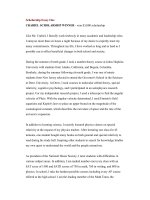alfred hitchcock biography essay
Bạn đang xem bản rút gọn của tài liệu. Xem và tải ngay bản đầy đủ của tài liệu tại đây (38.57 KB, 2 trang )
Alfred Hitchcock Obituary
Alfred Hitchcock, admired genius and master of film suspense, died of liver failure and heart
problems on April 28, 1980 in Los Angeles, California. He was the single most influential
director in the film genre of suspense, having partly created it, and is one of the most well known
and esteemed directors in the medium of film.
Hitchcock was born on August 13, 1899 in Leytonstone, England, the son of a grocer, William
Hitchcock, and his wife Emma. An interesting event occurred early in his life. When Hitchcock
was five, his father got mad at him for being mischievous, and sent young Hitchcock to the police
station with a note for the officer. Alfred was then locked up behind bars for awhile to think about
what he had done, and during this time he felt immense terror. It is thought that this had a
profound effect on the movies Hitchcock would go on to make; themes of innocent victims feeling
terror and confusion, as he did during this punishment, surfaced in many of his works.
Hitchcock received his education from St. Ignatius College (London), the School of Engineering
and Navigation, and the University of London, where he studied art.
Hitchcock's earliest film experience came in 1919, when he illustrated title cards for silent films
being produced at London's Players-Lasky studio. It was spending time at this studio that he
learned about many different aspects of film that would later be important in his film career,
including direction, stage art, and screen writing.
In 1922 Hitchcock met Alma Reville who he married in 1926. They went on to have a daughter,
Patricia.
Hitchcock's first mark as a film director came in 1925 with The Pleasure Garden. It was a largely
unimportant film, and was not recognized as being anything more than an average melodrama.
Writer Eliot Stannard, who worked with Hitchcock on the film, commented,
"Hitchcock, right from the beginning, always had a vision. How he worked at his first movie is
something I will never forget. He was born for movie making."
Hitchcock had far more success in 1926 with The Lodger, which introduced audiences to the
Hitchcock style that would be evident in many of his future films. It was a murder mystery with a
fair share of intrigue, and, though it was a silent film, still managed to produce what would
become the classic Hitchcock feeling of suspense.
It was also with The Lodger that Hitchcock started his trademark of making cameo appearances in
his films, something he has done in most of his films since. Other directors have followed in this
habit, including Cameron Crowe and Quentin Tarantino.
"I guess you could say I felt a bit like Hitchcock doing it", said Cameron Crowe, regarding his
brief appearance in his film Minority Report.
By 1929, Hitchcock had moved into sound films. 1934's The Man Who Knew Too Much was
Hitchcock's first big hit, and further developed Hitchcock's budding mastery of suspenseful film.
He continued to make movies in Britain until he moved to Hollywood in the early 1940. After a
few movies of what had now become tried and true Hitchcock, came 1946's Notorious which was
a hit and featured an FBI agent forced to turn over his love to Nazis in order to find out valuable
information.
Hitchcock's "golden age" of movies came from 1950 to 1960. Among the most memorable were
Dial "M" For Murder (1954), Vertigo (1958), North By Northwest (1959), and what is considered
Hitchcock's greatest achievement, Psycho (1960).
1955 was truly the year that saw Hitchcock become an icon, however. The TV show Alfred
Hitchcock Presents went on the air, and it was a huge success. This was also the year that
Hitchcock became a U.S. citizen.
"It was exciting to work with Hitchcock. I had admired him for so long, and was very happy to be
cast in North by Northwest. Although at times very difficult to work with, Hitchcock has a
spectacular mind and vision," said Cary Grant, shortly after playing Roger Thornhill.
Hitchcock continued to make films as an older man but they were far less frequent. His final film
came in 1976 with Family Plot, a good, solid film that was hailed by critics as a "fitting end" to
Hitchcock's masterful body of work.
"Hitchcock came across as very smart, very striking and at the top of his game when I worked
with him," said title designer Saul Bass, who worked with Hitchcock on Vertigo, North by
Northwest, and Psycho.
There are many people in all aspects of film that have at some point been influenced by the Master
of Suspense. Hitchcock worked with some of the finest names in film: Cary Grant, James Stewart,
Ingrid Bergman, and Grace Kelly to name a few. Some of those peoples' careers were even made
by Hitchcock.
Hitchcock received many honors, including being knighted in England shortly before his death in
1980. He stayed married all his life to Alma Reville, who died in 1982. Hitchcock is survived by
his daughter, Patricia Hitchcock O'Connell, and will be remembered by many generations to come
as the Master Of Suspense.









